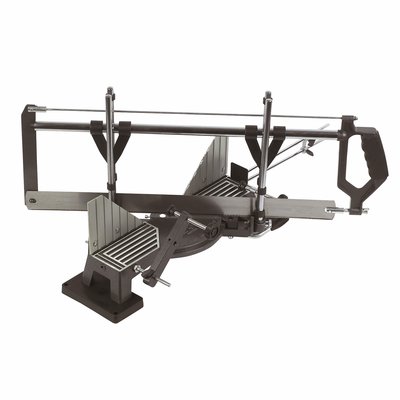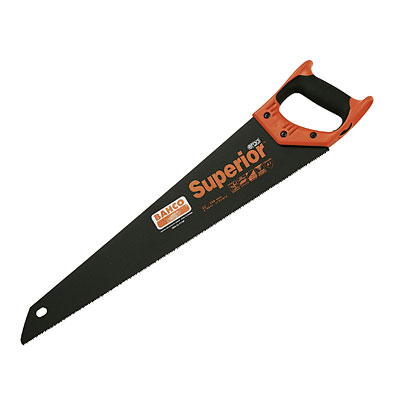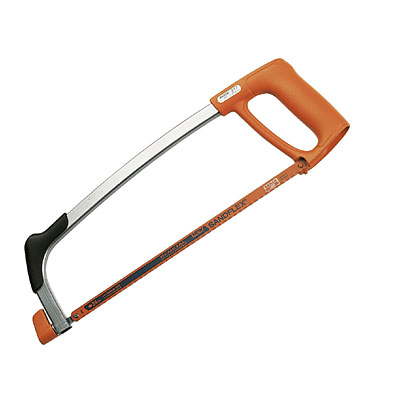5 different types of hand saws for cutting wood to length, straight or curved
By learning all of these different types of hand saws that are available to choose from for various DIY & Carpentry jobs you'll save a heap of time, effort and money and no doubt get a better finish for your project too.
Whilst it would be great to have one all round saw for all jobs, with so many different types of cuts to make in so many different materials it's almost always better to pick the best one for the task at hand.
I'll explain the different types of hand saws available that I use on site below. Which saw is best (and worst) for cutting wood/plastic/mitres/plasterboard etc., plus how I choose which blade to use in my saw when they are interchangeable.
As a general guide, the less teeth a hand saw has, the faster, rougher and more coarse the cut. Therefore rip cutting along the grain is better with a rougher saw with fewer but larger teeth. For finer cuts in more intricate types of timber, more smaller/finer teeth would be beneficial for a smoother, neater finish.
TPI stands for the number of teeth points per inch. For fast and rough work around 8tpi is good, and for fine work 12tpi+ works well for me. If you don't need to be too specific, for a good all round or general use handsaw aim for about 10 teeth per inch.
Less commonly mentioned these days, 'Saw Set' refers to the angle the teeth are bent over in either direction (out to the sides). This is so the actual cut is slightly wider than the main body of the blade itself and is important in order to prevent the timber pinching the blade during sawing, making cutting much more difficult. If your blade starts pinching it could be a sign it's time for a new one. Handsaws didn't used to be disposable, and it was normal for carpenters to sharpen their handsaws by hand! Saw set was important then, not so much any more as when dull
Hand saw blades are also 'taper ground' which means they are thinner at the top than the bottom - which again is to help prevent binding, allowing a smoother more efficient cut.
How do you look after and make your handsaws last longer?
No decent tools are cheap these days so and for all types of handsaws remember they will last much longer if you keep them dry (or dry them straight off after working in the rain) and protect the teeth from damage wherever possible. Most come with protective cases or plastic strips to minimise the damage from knocks.
Finally, try to use a full stroke when cutting with any handsaw. By that I mean start the cut at the furthest or nearest point of the saw and try to use all or as many of the teeth as possible. You might need to go slower but will cut more efficiently and your saw will wear evenly and last longer too.
How to choose the best Hardpoint, Coping, Tenon and Hack saw blades for various types of carpentry work
Use an Angled Compound Mitre saw for perfect mitre joints

If you don't have a powered chop-saw or are cutting small decorative mouldings then the best type of saw to use for mitre joints is a compound mitre saw.
These types of hand saws are great for 2nd fix carpentry work. That is cutting small intricate mouldings and skirting boards, architraves, beadings quadrant/scotia etc.) and even stair-parts with a fine, smooth cutting blade.
The saws cutting angle is adjustable left & right up to 45 degrees and the actual saw itself moves up and down on the rails which helps to keep the blade at the right pitch depending on the thickness and depth of the moulding you are cutting.
Click here to see the latest compound miter saw deals available at Amazon
Hardpoint panel saws for rip & cross cutting timber

The most common of all types of hand saws for carpentry work are panel saws. These handsaws are generally available in either 20 or 22 inch length. I prefer the 22" hand saw over the 20". Maybe a plumber or someone wanting a saw for occasional use might choose a 20" over 22" especially if it means it would fit in their toolbox or bag easier.
Whilst I keep a general use saw in the van for some work, for a lot of carpentry jobs I use a Bahco handsaw with interchangeable blades. I like that is a bit more sturdy than most disposable saws and has an more 'ergonomic' handle shaped much more like the inside of your hand than a regular carpentry hand saw.
This Bahco handsaw is much more comfortable and easier to control. It's not cheap and most reasonable quality handsaws are OK for day to day use, my only recommendation would be to choose the right one for the job, a fine saw for finish work and a rough one for framing jobs for example.
Some of the jobs I'll use a hard-point panel saw for include roofing carpentry, building timber stud-work walls & laying chipboard flooring.
When a panel saw is past its best and becomes a bit blunt, I keep hold of it for jobs that would otherwise dull the blade such as cutting plasterboard & cutting plastic fittings such as guttering or plastic plumbing pipes.
Click here for the latest deals on Bahco hard-point panel saws at Amazon
Use a Coping saw for cutting curved shapes in wood
A coping saw has a small, fine, thin blade held under tension at either end of a U shaped frame with a handle. The saws thin blade can be turned easily when cutting curved intricate cuts in timber mouldings.
The coping saw is definitely the best types of hand saws to use for scribing internal corners on mouldings like skirting boards, dado rails and picture rails during 2nd fix carpentry work.
Some people prefer to cut on the push stroke, but I prefer the blade to have the teeth pointing toward the handle and it therefore cuts the wood on the 'pull' stroke. This ensures that as I cut timber, the blade is being pulled tight at the same time, so it stays more rigid.
Just watch out as because you are pulling the teeth towards you, the face of the timber could break out if you are not careful or the blade isn't nice and sharp.
Coping saws can also be handy in situations where the blade needs to be taken off the handle, passed through a hole and then refitted to the handle. One example could be when cutting a keyhole to size without a specific keyhole saw. You might not otherwise be able to get to this without taking the blade out of the handle.
I use an eclipse coping saw for 2nd fix finishing carpentry work, for any jobs where a jigsaw is too a bit too powerful or cumbersome.
Click here for the latest deals on Eclipse Coping saws at Amazon
Pad saw / Keyhole saw / Sabre saw / Jab saw are the best types of hand saws for cutting holes in Gyproc and Celotex
Several names for similar tools (although the 'keyhole' version would have a much thinner more fragile blade for getting into er.. keyholes) this handsaw consists of a wooden handle with a blade directly attached, shaped a it like a knife. It is used like the name suggests, when cutting keyholes for mortice and other types of locks, plus as a 'jab' saw for getting into material through a hole rather than from the edge if that makes sense..
The 'pad-saw' types of hand saws with rough/coarse teeth are more often used these days for cutting plasterboard holes and notches for cables etc. during the first fix stages of carpentry work.
You wouldn't make too lengthy a cut in timber with a jab saw but is handy for enlarging holes in timber like soffits, barges, kitchen cabinets (for pipes).
Electricians probably use Jab saws most out of anyone on site for things like sockets, switches & speakers in plasterboard.
When a normal hand saw is too large, they are handy to have in your 'arsenal' or toolkit for those odd jobs that come up from time to time.
I use a Stanley Fat Max Jab Saw, it's really sharp & comes with a protective case that helps it last ages.
Use a Hack saw or mini hack-saw to cut metal to length

Never use a saw designed for cutting wood to cut metal! I'm trying to think of an exception to this rule and can't, you'll kill the saw and probably not get anywhere either and so still need a metal cutting saw!
A hack saw is designed for cutting metal but can also be good for cutting plastic too, such as guttering lengths and fittings. It's available in the size pictured above or as a junior version for smaller jobs.
I use my hacksaw mostly for cutting bolts, steel rod and door spindles to length on site.
Makes sure you buy the correct length blades for the frame/handle. These are held under tension in the frame, tighten as much as possible by hand - no need to use any tools.
Hack saws have 18-30 teeth per inch - more than a timber or wood cutting handsaw.
I also carry a small portable vice to hold them in while I'm cutting. If you don't have one of those, you can drill a hole in a piece of batten or other similar timber and push the bolt through that to hold it still while cutting it to length.
I use a heavy duty Stanley Dynagrip hacksaw which is a good solid saw.
Use the comments section below to add your own tips about which types of handsaws are best